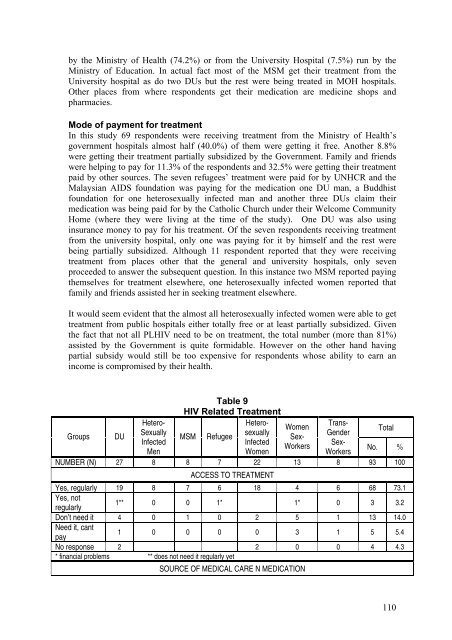Download this publication - AIDS Data Hub
Download this publication - AIDS Data Hub
Download this publication - AIDS Data Hub
Create successful ePaper yourself
Turn your PDF publications into a flip-book with our unique Google optimized e-Paper software.
y the Ministry of Health (74.2%) or from the University Hospital (7.5%) run by theMinistry of Education. In actual fact most of the MSM get their treatment from theUniversity hospital as do two DUs but the rest were being treated in MOH hospitals.Other places from where respondents get their medication are medicine shops andpharmacies.Mode of payment for treatmentIn <strong>this</strong> study 69 respondents were receiving treatment from the Ministry of Health’sgovernment hospitals almost half (40.0%) of them were getting it free. Another 8.8%were getting their treatment partially subsidized by the Government. Family and friendswere helping to pay for 11.3% of the respondents and 32.5% were getting their treatmentpaid by other sources. The seven refugees’ treatment were paid for by UNHCR and theMalaysian <strong>AIDS</strong> foundation was paying for the medication one DU man, a Buddhistfoundation for one heterosexually infected man and another three DUs claim theirmedication was being paid for by the Catholic Church under their Welcome CommunityHome (where they were living at the time of the study). One DU was also usinginsurance money to pay for his treatment. Of the seven respondents receiving treatmentfrom the university hospital, only one was paying for it by himself and the rest werebeing partially subsidized. Although 11 respondent reported that they were receivingtreatment from places other that the general and university hospitals, only sevenproceeded to answer the subsequent question. In <strong>this</strong> instance two MSM reported payingthemselves for treatment elsewhere, one heterosexually infected women reported thatfamily and friends assisted her in seeking treatment elsewhere.It would seem evident that the almost all heterosexually infected women were able to gettreatment from public hospitals either totally free or at least partially subsidized. Giventhe fact that not all PLHIV need to be on treatment, the total number (more than 81%)assisted by the Government is quite formidable. However on the other hand havingpartial subsidy would still be too expensive for respondents whose ability to earn anincome is compromised by their health.Groups DUTable 9HIV Related TreatmentHetero-Hetero-Trans-WomenTotalSexuallysexuallyGenderMSM RefugeeSex-InfectedInfectedSex-WorkersNo. %MenWomenWorkersNUMBER (N) 27 8 8 7 22 13 8 93 100ACCESS TO TREATMENTYes, regularly 19 8 7 6 18 4 6 68 73.1Yes, notregularly1** 0 0 1* 1* 0 3 3.2Don’t need it 4 0 1 0 2 5 1 13 14.0Need it, cantpay1 0 0 0 0 3 1 5 5.4No response 2 2 0 0 4 4.3* financial problems ** does not need it regularly yetSOURCE OF MEDICAL CARE N MEDICATION110















